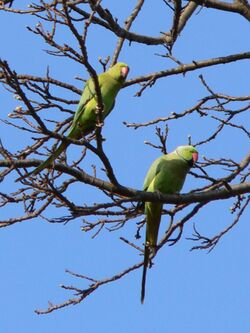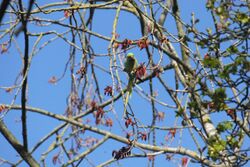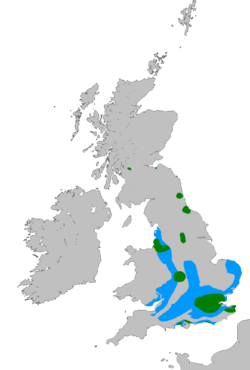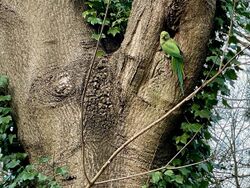Biology:Feral parakeets in Great Britain
Feral parakeets in Great Britain are wild-living, non-native parakeets that are an introduced species into Great Britain. The population mainly consists of rose-ringed parakeets (Psittacula krameri), a non-migratory species of bird native to Africa and the Indian Subcontinent, with a few, small breeding populations of monk parakeets, and other occasional escaped cage birds. The origins of these birds are subject of speculation, but they are generally thought to have bred from birds that escaped from captivity or were released.
The British rose-ringed parakeet or ringneck parrot population is mostly concentrated in suburban areas of London and the Home Counties of South-East England, and for this reason the birds are sometimes known as "Kingston parakeets" or "Twickenham parakeets", after the London suburbs of Kingston upon Thames and Twickenham. The parakeets breed rapidly and have spread beyond these areas: Flocks have been sighted in other parts of Britain. Separate feral rose-ringed parakeet populations exist in and around other European cities.
Origin of the birds
How exactly the rose-ringed parakeet population first came to exist and thrive in the wild in England is not known; however, theories abound, most centred around a pair or more of breeding parakeets that escaped or were released from captivity some time in the mid-1990s, consistent with the first widespread photographs of the birds.
More specific introduction theories explaining the origin of the birds have also been published:[1]
- Parakeets that escaped from the branch of Ealing Studios used for the filming of The African Queen (Isleworth Studios) in 1951[2][3][4]
- A number of parakeets reportedly escaped from a pet shop in Sunbury-on-Thames in 1970[5]
Most ornithologists believe that the original birds likely escaped from aviaries before 1971.[6] In terms of geographic origin, the British rose-ringed parakeets are thought to be a hybrid population of two Asian subspecies, P.k. borealis and P.k. manillensis.[7]
Population in Britain
Despite the increase in notability and population size at the end of the 20th and beginning of the 21st centuries, escaped parakeets have been spotted in Britain since the 19th century. The earliest recorded sighting was in 1855 in Norfolk, and parakeets were also seen in Dulwich in 1893 and Brixton in 1894.
Throughout the decades since, parakeets continued to variously escape captivity; however, populations repeatedly died out until 1969, when the population of parakeets began to breed and sustain itself in London for the first time. Beginning in Croydon, the parakeets spread to Wraysbury, Bromley, and Esher.[5]
The numbers remained very low, however, until the mid-1990s, when the population appeared to start increasing rapidly. The population was estimated at 500 birds in 1983, reached 1,500 by 1996, and 5,800 in the London area in 2002 (sheltering in up to 5 roosts).[9] The last official roost count, in 2012, recorded 32,000 parakeets in London. [10]
British rose-ringed parakeets are most common in the south-east of England, including London suburbs, Surrey, Kent and Sussex. Parakeet populations have also been reported further north in Liverpool, Oxford, Birmingham, Manchester, Leeds, Bradford, Sheffield, Edinburgh, and Newcastle[8][3][11][12]
Due to population growth and the relatively quick spread throughout Britain, estimates of parakeet numbers within the country vary. According to the London Natural History Society, in the early 2000s the largest population of rose-ringed parakeets was believed to exist in the South London suburbs, where the birds roosted principally in Esher Rugby Ground, Esher until 2007 (Esher Rugby Club named its women's team "The Parakeets" in a tribute to the birds).[1][13] In 2017, The Royal Society for the Protection of Birds (RSPB) estimated there to be around 8,600 breeding pairs in Britain.[8] Other scientific counts conducted in 2012 placed the number at around 32,000 birds.[4] The rose-ringed parakeet is scientifically monitored by the British Trust for Ornithology (BTO) and, as of 2022, estimate about 12,000 breeding pairs.[14]
Ecological impact
Concerns have been raised by Hazel Jackson, an expert in invasive species and conservation at the University of Kent, over the impact of the growing numbers of rose-ringed parakeets in south-east England.[11] Scientific research programmes have analysed the behaviour of parakeets and found that they compete with native bird species and bats for food and nesting sites.[citation needed] Although not aggressive, parakeets have been shown to deter smaller birds due to their behaviour and noise; their large size means that they often crowd small bird feeders, further increasing competition for resources and disrupting local ecosystems.
The detrimental effect of competitive exclusion has been likened to the impact of the introduction of grey squirrel on the red squirrel. However, rose-ringed parakeets do have natural predators native to Britain: Ornithologists have observed an increase in the population of birds of prey in London, and have reported sparrowhawks, peregrine falcons, and hobbies preying on parakeets.[6]
Rose-ringed parakeets are considered a pest in many countries such as Israel, where large swarms of parakeets can have a devastating effect on certain crops, and there is concern that the rapidly growing parakeet population could have unforeseen environmental impact in Britain.[3][4] In 2009, the governmental wildlife organisation Natural England added feral parakeets to the “general licence”, a list of wild species that can be lawfully culled without the need for specific permission.[15] Feral monk parakeets (Myiopsitta monachus) were subsequently also covered by the licence.[16] In March 2021, the Department for Environment, Food and Rural Affairs stated that no cull of the ring-necked parakeet population in the UK was planned.[17]
See also
- British avifauna
- Feral parrot
- List of birds of Great Britain
- List of non-native birds of Great Britain
- Monk parakeet – another feral parakeet species, also found in Britain.
References
- ↑ Jump up to: 1.0 1.1 "Tropical birds move into Surrey". 2 October 2009. http://news.bbc.co.uk/local/surrey/hi/people_and_places/nature/newsid_8286000/8286707.stm.
- ↑ Jump up to: 2.0 2.1 2.2 "Wild parrots settle in suburbs". 6 July 2004. http://news.bbc.co.uk/1/hi/education/3869815.stm.
- ↑ Jump up to: 3.0 3.1 3.2 3.3 3.4 Copping, Jasper (20 April 2014). "Noisy parakeets 'drive away' native birds". The Telegraph. https://www.telegraph.co.uk/news/earth/wildlife/10776252/Noisy-parakeets-drive-away-native-birds.html.
- ↑ Jump up to: 4.0 4.1 4.2 4.3 4.4 Oliver, Brian (1 July 2017). "Exotic and colourful – But should parakeets be culled? ask scientists". The Observer. https://www.theguardian.com/environment/2017/jul/01/parakeet-cull-british-farms-birds-vineyards-research-uk.
- ↑ Jump up to: 5.0 5.1 Self, Andrew (2014) (in en). The Birds of London. A&C Black. p. 245. ISBN 9781472905147. https://books.google.com/books?id=bBDNAgAAQBAJ&q=london%20parakeets&pg=PA245. Retrieved 30 October 2017.
- ↑ Jump up to: 6.0 6.1 McCarthy, Michael (8 June 2015). "Nature Studies: London's beautiful parakeets have a new enemy to deal with". The Independent. https://www.independent.co.uk/voices/comment/nature-studies-london-s-beautiful-parakeets-have-a-new-enemy-to-deal-with-10305901.html.
- ↑ Pithon, J.A.; Dytham, C. (2001). "Determination of the origin of British feral rose-ringed parakeets". British Birds 94 (2): 74–79. https://britishbirds.co.uk/wp-content/uploads/article_files/V94/V94_N02/V94_N02_P074_079_A003.pdf. Retrieved 27 March 2018.
- ↑ Jump up to: 8.0 8.1 8.2 "Ring-necked parakeet". Royal Society for the Protection of Birds (RSPB). https://www.rspb.org.uk/birds-and-wildlife/bird-and-wildlife-guides/bird-a-z/r/ringneckedparakeet/#AgpwcLYhO40P1dZp.99.
- ↑ Butler, Christopher John (2003). Population Biology of the Introduced Rose-Ringed Parakeet Psittacula krameri in the UK (PhD). Department of Zoology, Edward Grey Institute of Field Ornithology. Oxford University. Retrieved 30 October 2017.
- ↑ "Most Googled: Why are there parakeets in London?". https://www.timeout.com/london/news/most-googled-why-are-there-parakeets-in-london-050219.
- ↑ Jump up to: 11.0 11.1 "Sheffield's exotic wild parakeets could be killed in bird cull, say scientists". The Star. 3 July 2017. https://www.thestar.co.uk/news/sheffields-exotic-wild-parakeets-could-be-killed-bird-cull-say-scientists-1774275.
- ↑ "Watch: Exotic wild parakeets caught on camera at Yorkshire nature reserve". 18 February 2018. https://www.yorkshirepost.co.uk/news/watch-exotic-wild-parakeets-caught-camera-yorkshire-nature-reserve-588446.
- ↑ London Bird Report (Report). London Natural History Society. 2006. p. 93. ISBN 0-901009-22-9.
- ↑ "Ring-necked Parakeet". British Trust for Ornithology (BTO). https://www.bto.org/understanding-birds/birdfacts/ring-necked-parakeet.
- ↑ "Britain's naturalised parrot now officially a pest". The Independent. 30 September 2009. https://www.independent.co.uk/environment/nature/britains-naturalised-parrot-now-officially-a-pest-1795555.html.
- ↑ "Licence to kill or take certain species of wild birds to conserve wild birds and to conserve flora and fauna". https://www.gov.uk/government/publications/wild-birds-licence-to-kill-or-take-for-conservation-purposes-gl34/licence-to-kill-or-take-certain-species-of-wild-birds-to-conserve-wild-birds-and-to-conserve-flora-and-fauna-gl34.
- ↑ Tigwell, Reiss (11 March 2021). "DEFRA is not planning ring-necked parakeet cull". https://www.swlondoner.co.uk/news/11032021-defra-is-not-planning-ring-necked-parakeet-cull/.
External links
- "Spot the parakeet" (in en-gb). Archived from the original. Error: If you specify
|archiveurl=, you must also specify|archivedate=. https://web.archive.org/web/20171030110335/http://www.bbc.co.uk/blackcountry/content/articles/2009/06/01/parakeet_feature.shtml. - Self, Will (29 January 2016). "On location: parakeets in London". http://will-self.com/2016/01/29/4618/.
- "The feral parakeets of Battersea". http://www.feralparakeets.co.uk. — observations of the parakeets in Battersea, London
 |






